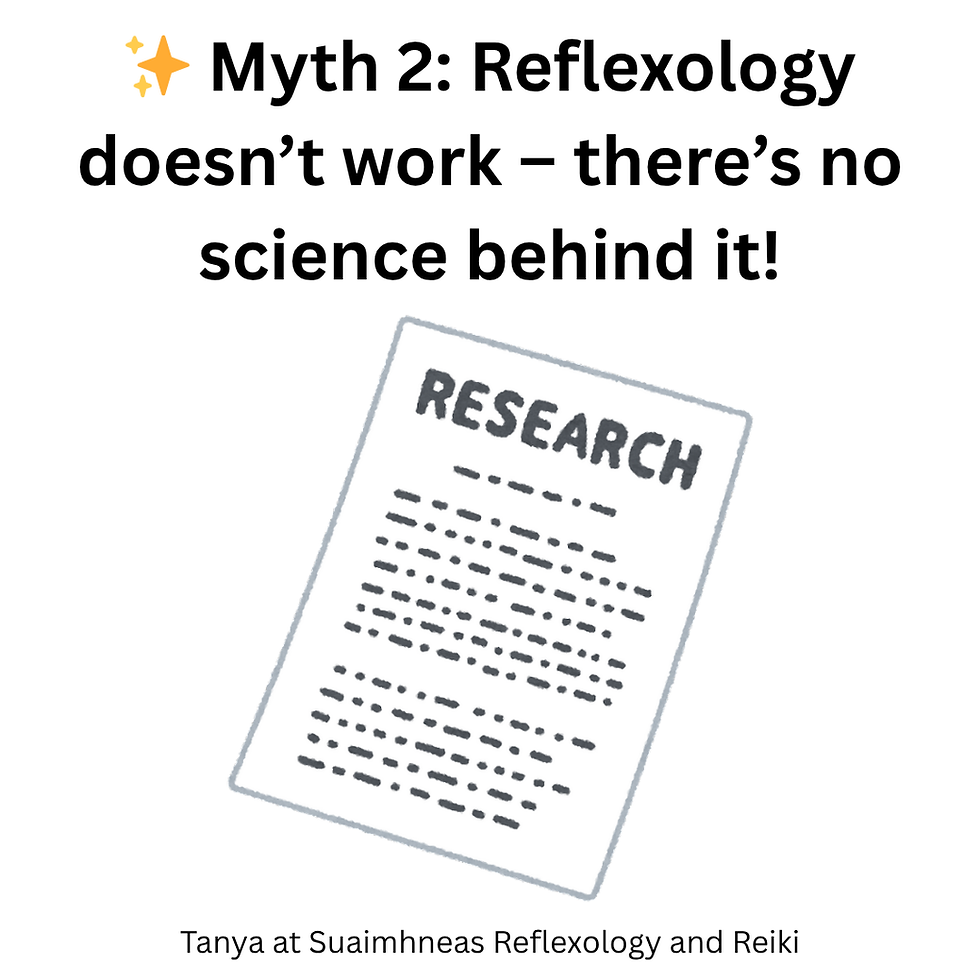Myth 4 – Reflexology Is Only for Your Feet? Think Again.
- Tanya

- Aug 9
- 3 min read
When most people hear the word “reflexology,” they immediately think of feet. And for good reason—foot reflexology is the most commonly practised form and is often what introduces people to this gentle, yet powerful therapy.
But here's the truth: reflexology is not just for feet. In fact, the principles of reflexology can be applied to multiple areas of the body, including the hands, ears, and face. These different approaches all use reflex points—specific areas that correspond with organs, glands, and systems throughout the body—to support wellbeing, restore balance, and ease tension.
Let’s take a closer look.
Foot Reflexology
This is the most traditional and widely recognised form, where pressure is applied to reflex zones on the feet that mirror the entire body. There are over 7,000 nerve endings in each foot, making them a perfect access point to the nervous system. This is one of the reasons foot reflexology is so effective for calming the body and promoting deep relaxation.
But if you’re not comfortable with your feet being touched—or if you have mobility or medical conditions affecting your feet—there are fantastic alternatives.
Hand Reflexology
Hand reflexology works in the same way as foot reflexology but focuses on pressure points on the palms and fingers. The hands are also richly innervated and connected to the brain, which means stimulating these points can have a calming and balancing effect.
Great for people who are ticklish or foot-shy
Perfect for self-care between sessions
Can be easily taught for use at home
Research highlight (07.08.2023): Hand reflexology massage was effective in reducing pain and anxiety in patients during the immediate postoperative period after coronary artery bypass graft surgery.
Ear Reflexology (Auricular Therapy)
Used in both Eastern and Western medicine, ear reflexology involves gentle stimulation of points on the ear that correspond with various systems in the body. These reflexes are part of the auricular map, a microsystem of the body.
This technique is often used to support:
Stress relief
Pain management
Hormonal balance
Smoking cessation and addiction support
Many complementary practitioners and even acupuncturists integrate ear reflexology into their treatments because of its calming effect on the autonomic nervous system.
Research highlight (22.10.2024): Comparing auricular acupressure (AA) and foot reflexology(FR) for pain and anxiety post c-section. The results show both therapies reduce pain at one hour post treatment, but at 2 hours post-intervention the AA was better at relieving pain. However, reflexology was statistically significantly better at reducing posy-operative anxiety.
Facial Reflexology
Facial reflexology combines ancient traditions with modern neuroscience. It involves working on reflex points on the face, helping to calm the nervous system, stimulate circulation, and support healing.
Benefits include:
Deep relaxation
Release of facial tension (especially for jaw clenching, eye strain and headaches)
Improved circulation and lymphatic drainage
A subtle lift and glow to the skin!
Because the face is so close to the brain and cranial nerves, facial reflexology is deeply soothing, often helping clients switch quickly from a stressed state to a restful one.
Research highlight (08.05.2007): The effects of foot and facial massage on sleep induction, blood pressure, pulse and respiratory rate: crossover pilot study. They found that foot and face massage; Both treatments were equally effective in reducing subjective levels of alertness during the interventions, with face massage marginally better at producing subjective sleepiness
Why Multiple Reflexology Options Matter
The beauty of reflexology lies in its adaptability. Whether a person prefers not to have their feet touched, lives with certain medical conditions, or just wants to try something new—reflexology can meet them where they are.
It’s a truly inclusive therapy.
Whether working on feet, hands, ears, or face, the goal remains the same: to stimulate reflexes, support the body's natural healing response, and promote deep relaxation and wellbeing.
Final Thoughts
So next time someone tells you reflexology is just about feet, you can smile and gently share what you know—it’s a whole-body therapy with many entry points. If you're curious about trying a different kind of reflexology session, I’d love to chat with you about what might suit you best.
Warmest wishes,Tanya x




